Future Changes in Hydro-Climatic Extremes across Vietnam: Evidence from a Semi-Distributed Hydrological Model Forced by Downscaled CMIP6 Climate Data
Abstract
1. Introduction
2. Materials and Methods
2.1. Study Area
- Xa La catchment (hereafter referred to as XLA): a tributary of the Ma River basin down to Xa La hydrological station in the northwest climate region (denoted as R1 region in Figure 2);
- Chu catchment (CHU): a tributary of the Hong–Thai Binh River basin down to Chu hydrological station in the northeast climate region (denoted as R2 region in Figure 2);
- Nghia Khanh catchment (NKH): a tributary of the Ca River basin down to Nghia Khanh hydrological station in the North Delta climate region (denoted as R3 region in Figure 2);
- Son Diem catchment (SDI): a tributary of the Ca River basin down to Son Diem hydrological station in the north-central climate region (denoted as R4 in Figure 2);
- An Hoa catchment (AHO): a tributary of the Tra Khuc River basin down to An Hoa hydrological station in the south-central climate region (denoted as R5 in Figure 2);
- Giang Son catchment (GSO): a tributary of the Srepok River basin down to Giang Son hydrological station in the Central Highlands climate region (denoted as R6 in Figure 2); and
- Can Dang catchment (CDA): a tributary of the Sai Gon–Dong Nai River basin down to Can Dang hydrological station in the southern and Mekong Delta climate region (denoted as R7 in Figure 2).
2.2. Data Collection
2.2.1. Hydro-Climate Records
2.2.2. Downscaled Climate Projections
2.3. Hydrological Model Development and Validation
- For topography data, we used the Terra Advanced Spaceborne Thermal Emission and Reflection Radiometer (ASTER) digital elevation model (D.E.M.). This dataset is jointly developed by the National Aeronautics and Space Administration and Japan’s Ministry of Economic, Trade, and Industry and was downloaded from USGS’s Earth Explorer website (https://earthexplorer.usgs.gov/; access date: 20 February 2024).
- For land use data, we used the European Space Agency Climate Change Initiative Land Cover dataset (ESA-LC) (available at https://www.esa-landcover-cci.org; access date: 20 February 2024) and modified the classification to obtain information appropriate to the SWAT model’s structure [47].
2.4. Assessing Climate Changes and Variability
- To assess temperature extremes, we computed the annual hottest day index (TXx), represented by the yearly maximum value of the maximum daily temperature.
- To assess rainfall extremes, we computed the maximum daily rainfall amount (Rx1day), represented by the yearly maximum value of daily rainfall.
- To assess streamflow extremes, we computed the discharge value exceeded only 5% of the time in a year (Q5).
3. Results
3.1. SWAT Model Performance
3.2. Projected Changes in Temperature Indices
3.3. Projected Changes in Precipitation Indices
3.4. Projected Changes in Streamflow Indices
4. Summary and Conclusions
- Among the three assessed extreme indices, the annual hottest day (TXx) shows the most robust increase (up to 4.8 °C). The detected increase is also statistically significant across both future time slices, confirming previous findings on the increasing trend in extreme temperature in the Anthropocene over Vietnam.
- Changes in maximum daily rainfall amount (Rx1day) identified in this study are less robust, but an overall increase (up to 43 mm) is detected across all analyses, although the magnitude of the change is not statistically significant in some specific cases.
- Streamflow extremes, as indicated by the Q5 index (the value that exceeds the streamflow time series by 5% in a year), exhibit the most complex pattern of change, as well as high uncertainty across all simulations (especially over the southern catchments). Although the detected changes are not statistically significant in some cases (e.g., changes in the Q5 index over the GSO catchment—located upstream of Srepok River—are not significant over both assessed periods under the SSP3–7.0 emission scenario), a rise (up to 31%) in streamflow extremes remains the key signal, indicating a future with higher flood-related events across the country.
Supplementary Materials
Author Contributions
Funding
Data Availability Statement
Conflicts of Interest
References
- WMO Economic Costs of Weather-Related Disasters Soars but Early Warnings Save Lives. Available online: https://wmo.int/media/news/economic-costs-of-weather-related-disasters-soars-early-warnings-save-lives (accessed on 5 January 2024).
- Pörtner, H.O.; Roberts, D.C.; Adams, H.; Adler, C.; Aldunce, P.; Ali, E.; Begum, R.A.; Betts, R.; Kerr, R.B.; Biesbroek, R. Climate Change 2022: Impacts, Adaptation and Vulnerability; IPCC: Geneva, Switzerland, 2022. [Google Scholar]
- Fowler, H.J.; Lenderink, G.; Prein, A.F.; Westra, S.; Allan, R.P.; Ban, N.; Barbero, R.; Berg, P.; Blenkinsop, S.; Do, H.X.; et al. Anthropogenic Intensification of Short-Duration Rainfall Extremes. Nat. Rev. Earth Environ. 2021, 2, 107–122. [Google Scholar] [CrossRef]
- Najibi, N.; Steinschneider, S. Extreme Precipitation-Temperature Scaling in California: The Role of Atmospheric Rivers. Geophys. Res. Lett. 2023, 50, e2023GL104606. [Google Scholar] [CrossRef]
- Almazroui, M.; Saeed, F.; Saeed, S.; Ismail, M.; Ehsan, M.A.; Islam, M.N.; Abid, M.A.; O’Brien, E.; Kamil, S.; Rashid, I.U.; et al. Projected Changes in Climate Extremes Using CMIP6 Simulations Over SREX Regions. Earth Syst. Environ. 2021, 5, 481–497. [Google Scholar] [CrossRef]
- Blöschl, G. Three Hypotheses on Changing River Flood Hazards. Hydrol. Earth Syst. Sci. 2022, 26, 5015–5033. [Google Scholar] [CrossRef]
- Blöschl, G.; Hall, J.; Viglione, A.; Perdigão, R.A.P.; Parajka, J.; Merz, B.; Lun, D.; Arheimer, B.; Aronica, G.T.; Bilibashi, A.; et al. Changing Climate Both Increases and Decreases European River Floods. Nature 2019, 573, 108–111. [Google Scholar] [CrossRef] [PubMed]
- Do, H.X.; Mei, Y.; Gronewold, A.D. To What Extent Are Changes in Flood Magnitude Related to Changes in Precipitation Extremes? Geophys. Res. Lett. 2020, 47, e2020GL088684. [Google Scholar] [CrossRef]
- Do, H.X.; Westra, S.; Leonard, M. A Global-Scale Investigation of Trends in Annual Maximum Streamflow. J. Hydrol. 2017, 552, 28–43. [Google Scholar] [CrossRef]
- Sharma, A.; Wasko, C.; Lettenmaier, D.P. If Precipitation Extremes Are Increasing, Why Aren’t Floods? Water Resour. Res. 2018, 54, 8545–8551. [Google Scholar] [CrossRef]
- Eyring, V.; Bony, S.; Meehl, G.A.; Senior, C.A.; Stevens, B.; Stouffer, R.J.; Taylor, K.E. Overview of the Coupled Model Intercomparison Project Phase 6 (CMIP6) Experimental Design and Organization. Geosci. Model Dev. 2016, 9, 1937–1958. [Google Scholar] [CrossRef]
- Do, H.X.; Zhao, F.; Westra, S.; Leonard, M.; Gudmundsson, L.; Boulange, J.E.S.; Chang, J.; Ciais, P.; Gerten, D.; Gosling, S.N.; et al. Historical and Future Changes in Global Flood Magnitude—Evidence from a Model–Observation Investigation. Hydrol. Earth Syst. Sci. 2020, 24, 1543–1564. [Google Scholar] [CrossRef]
- Swain, D.L.; Wing, O.E.J.; Bates, P.D.; Done, J.M.; Johnson, K.A.; Cameron, D.R. Increased Flood Exposure Due to Climate Change and Population Growth in the United States. Earth’s Futur. 2020, 8, e2020EF001778. [Google Scholar] [CrossRef]
- Edamo, M.L.; Hatiye, S.D.; Minda, T.T.; Ukumo, T.Y. Flood Inundation and Risk Mapping under Climate Change Scenarios in the Lower Bilate Catchment, Ethiopia. Nat. Hazards 2023, 118, 2199–2226. [Google Scholar] [CrossRef]
- Blöschl, G.; Bierkens, M.F.P.; Chambel, A.; Cudennec, C.; Destouni, G.; Fiori, A.; Kirchner, J.W.; McDonnell, J.J.; Savenije, H.H.G.; Sivapalan, M.; et al. Twenty-Three Unsolved Problems in Hydrology (UPH)–a Community Perspective. Hydrol. Sci. J. 2019, 64, 1141–1158. [Google Scholar] [CrossRef]
- Do, H.X.; Gudmundsson, L.; Leonard, M.; Westra, S. The Global Streamflow Indices and Metadata Archive (GSIM)-Part 1: The Production of a Daily Streamflow Archive and Metadata. Earth Syst. Sci. Data 2018, 10, 765–785. [Google Scholar] [CrossRef]
- Addor, N.; Do, H.X.; Alvarez-Garreton, C.; Coxon, G.; Fowler, K.; Mendoza, P.A. Large-Sample Hydrology: Recent Progress, Guidelines for New Datasets and Grand Challenges. Hydrol. Sci. J. 2020, 65, 712–725. [Google Scholar] [CrossRef]
- John, A.; Douville, H.; Ribes, A.; Yiou, P. Quantifying CMIP6 Model Uncertainties in Extreme Precipitation Projections. Weather Clim. Extrem. 2022, 36, 100435. [Google Scholar] [CrossRef]
- World_Bank Vietnam Country Climate and Development Report; World Bank: Washington, DC, USA, 2022.
- Nguyen, H.Q.; Degener, J.; Kappas, M. Flash Flood Prediction by Coupling KINEROS2 and HEC-RAS Models for Tropical Regions of Northern Vietnam. Hydrology 2015, 2, 242–265. [Google Scholar] [CrossRef]
- Nguyen, H.Q.; Degener, J.; Kappas, M. Flash Flooding Prediction in Regions of Northern Vietnam Using the KINEROS2 Model. Hydrol. Res. 2016, 47, 1038–1052. [Google Scholar] [CrossRef]
- Do, T.A.T.; Do, A.N.T.; Tran, H.D. Quantifying the Spatial Pattern of Urban Expansion Trends in the Period 1987–2022 and Identifying Areas at Risk of Flooding Due to the Impact of Urbanization in Lao Cai City. Ecol. Inform. 2022, 72, 101912. [Google Scholar] [CrossRef]
- Nguyen, H.D.; Ardillier-Carras, F.; Touchart, L. Les Paysages de Rizières et Leur Évolution Récente Dans Le Delta Du Fleuve Gianh. Cybergeo Eur. J. Geogr. 2018. [Google Scholar] [CrossRef]
- Nguyen, H.D.; Fox, D.; Dang, D.K.; Pham, L.T.; Viet Du, Q.V.; Nguyen, T.H.T.; Dang, T.N.; Tran, V.T.; Vu, P.L.; Nguyen, Q.-H. Predicting Future Urban Flood Risk Using Land Change and Hydraulic Modeling in a River Watershed in the Central Province of Vietnam. Remote Sens. 2021, 13, 262. [Google Scholar] [CrossRef]
- Tyler, S.; Nguyen, H.; Tran, P. Urban Development and Flood Risk in Vietnam: Experience in Three Cities: Synthesis of Flood Case Studies and Planning Context; ISET: Boulder, CO, USA, 2015. [Google Scholar]
- Triet, N.V.K.; Dung, N.V.; Hoang, L.P.; Le Duy, N.; Tran, D.D.; Anh, T.T.; Kummu, M.; Merz, B.; Apel, H. Future Projections of Flood Dynamics in the Vietnamese Mekong Delta. Sci. Total Environ. 2020, 742, 140596. [Google Scholar] [CrossRef]
- Hoang, L.P.; Biesbroek, R.; Tri, V.P.D.; Kummu, M.; van Vliet, M.T.H.; Leemans, R.; Kabat, P.; Ludwig, F. Managing Flood Risks in the Mekong Delta: How to Address Emerging Challenges under Climate Change and Socioeconomic Developments. Ambio 2018, 47, 635–649. [Google Scholar] [CrossRef] [PubMed]
- Takagi, H.; Van Ty, T.; Thao, N.D. Investigation on Floods in Can Tho City: Influence of Ocean Tides and Sea Level Rise for the Mekong Delta’s Largest City. In Coastal Disasters and Climate Change in Vietnam; Elsevier: Amsterdam, The Netherlands, 2014; pp. 257–274. [Google Scholar]
- Tran, P.; Marincioni, F.; Shaw, R. Catastrophic Flood and Forest Cover Change in the Huong River Basin, Central Viet Nam: A Gap between Common Perceptions and Facts. J. Environ. Manag. 2010, 91, 2186–2200. [Google Scholar] [CrossRef] [PubMed]
- Vo, N.D.; Gourbesville, P.; Vu, M.T.; Raghavan, S.V.; Liong, S.-Y. A Deterministic Hydrological Approach to Estimate Climate Change Impact on River Flow: Vu Gia–Thu Bon Catchment, Vietnam. J. Hydro-Environ. Res. 2016, 11, 59–74. [Google Scholar] [CrossRef]
- To, T.N.; Vu, H.C.; Le, H. Impacts of Reservoir Operation and Urbanization on Flood Inundation in The Vu Gia Thu Bon Basin, Vietnam. Water Supply 2022, 22, 4656–4675. [Google Scholar] [CrossRef]
- Pham Quang, M.; Tallam, K. Predicting Flood Hazards in the Vietnam Central Region: An Artificial Neural Network Approach. Sustainability 2022, 14, 11861. [Google Scholar] [CrossRef]
- Nguyen, H.D. GIS-Based Hybrid Machine Learning for Flood Susceptibility Prediction in the Nhat Le–Kien Giang Watershed, Vietnam. Earth Sci. Inform. 2022, 15, 2369–2386. [Google Scholar] [CrossRef]
- Nguyen, M.T.; Sebesvari, Z.; Souvignet, M.; Bachofer, F.; Braun, A.; Garschagen, M.; Schinkel, U.; Yang, L.E.; Nguyen, L.H.K.; Hochschild, V. Understanding and Assessing Flood Risk in Vietnam: Current Status, Persisting Gaps, and Future Directions. J. Flood Risk Manag. 2021, 14, e12689. [Google Scholar] [CrossRef]
- Phan-Van, T.; Ngo-Duc, T.; Ho, T.M.H. Seasonal and Interannual Variations of Surface Climate Elements over Vietnam. Clim. Res. 2009, 40, 49–60. [Google Scholar] [CrossRef]
- Nguyen-Xuan, T.; Ngo-Duc, T.; Kamimera, H.; Trinh-Tuan, L.; Matsumoto, J.; Inoue, T.; Phan-Van, T. The Vietnam Gridded Precipitation (VnGP) Dataset: Construction and Validation. SOLA 2016, 12, 291–296. [Google Scholar] [CrossRef]
- Pokhrel, Y.; Burbano, M.; Roush, J.; Kang, H.; Sridhar, V.; Hyndman, D.W. A Review of the Integrated Effects of Changing Climate, Land Use, and Dams on Mekong River Hydrology. Water 2018, 10, 266. [Google Scholar] [CrossRef]
- Yuen, K.W.; Hanh, T.T.; Quynh, V.D.; Switzer, A.D.; Teng, P.; Lee, J.S.H. Interacting Effects of Land-Use Change and Natural Hazards on Rice Agriculture in the Mekong and Red River Deltas in Vietnam. Nat. Hazards Earth Syst. Sci. 2021, 21, 1473–1493. [Google Scholar] [CrossRef]
- Khoi, D.N.; Suetsugi, T. Impact of Climate and Land-Use Changes on Hydrological Processes and Sediment Yield—A Case Study of the Be River Catchment, Vietnam. Hydrol. Sci. J. 2014, 59, 1095–1108. [Google Scholar] [CrossRef]
- Do, Q.V.; Do, H.X.; Do, N.C.; Ngo, A.L. Changes in Precipitation Extremes across Vietnam and Its Relationships with Teleconnection Patterns of the Northern Hemisphere. Water 2020, 12, 1646. [Google Scholar] [CrossRef]
- Do, H.X.; Le, M.-H.; Pham, H.T.; Le, T.H.; Nguyen, B.Q. Identifying Hydrologic Reference Stations to Understand Changes in Water Resources across Vietnam-a Data-Driven Approach. Vietnam. J. Earth Sci. 2022, 44, 145–165. [Google Scholar]
- Rodell, M.; Houser, P.R.; Jambor, U.E.A.; Gottschalck, J.; Mitchell, K.; Meng, C.-J.; Arsenault, K.; Cosgrove, B.; Radakovich, J.; Bosilovich, M. The Global Land Data Assimilation System. Bull. Am. Meteorol. Soc. 2004, 85, 381–394. [Google Scholar] [CrossRef]
- Tan, M.L.; Juneng, L.; Kuswanto, H.; Do, H.X.; Zhang, F. Impacts of Solar Radiation Management on Hydro-Climatic Extremes in Southeast Asia. Water 2023, 15, 1089. [Google Scholar] [CrossRef]
- Zhou, J.; He, D.; Xie, Y.; Liu, Y.; Yang, Y.; Sheng, H.; Guo, H.; Zhao, L.; Zou, R. Integrated SWAT Model and Statistical Downscaling for Estimating Streamflow Response to Climate Change in the Lake Dianchi Watershed, China. Stoch. Environ. Res. Risk Assess. 2015, 29, 1193–1210. [Google Scholar] [CrossRef]
- Tran-Anh, Q.; Ngo-Duc, T.; Espagne, E.; Trinh-Tuan, L. A 10-Km CMIP6 Downscaled Dataset of Temperature and Precipitation for Historical and Future Vietnam Climate. Sci. Data 2023, 10, 257. [Google Scholar] [CrossRef]
- Arias, P.; Bellouin, N.; Coppola, E.; Jones, R.; Krinner, G.; Marotzke, J.; Naik, V.; Palmer, M.; Plattner, G.-K.; Rogelj, J. Climate Change 2021: The Physical Science Basis. In Contribution of Working Group I to the Sixth Assessment Report of the Intergovernmental Panel on Climate Change; Technical Summary; IPCC: Geneva, Switzerland, 2021. [Google Scholar]
- Arnold, J.G.; Srinivasan, R.; Muttiah, R.S.; Williams, J.R. Large Area Hydrologic Modeling and Assessment Part I: Model Development 1. JAWRA J. Am. Water Resour. Assoc. 1998, 34, 73–89. [Google Scholar] [CrossRef]
- Abbaspour, K.C.; Johnson, C.A.; Van Genuchten, M.T. Estimating Uncertain Flow and Transport Parameters Using a Sequential Uncertainty Fitting Procedure. Vadose Zo. J. 2004, 3, 1340–1352. [Google Scholar] [CrossRef]
- Moriasi, D.N.; Arnold, J.G.; Van Liew, M.W.; Bingner, R.L.; Harmel, R.D.; Veith, T.L. Model Evaluation Guidelines for Systematic Quantification of Accuracy in Watershed Simulations. Trans. ASABE 2007, 50, 885–900. [Google Scholar] [CrossRef]
- Nash, J.E.; Sutcliffe, J. V River Flow Forecasting through Conceptual Models Part I—A Discussion of Principles. J. Hydrol. 1970, 10, 282–290. [Google Scholar] [CrossRef]
- Massoud, E.C.; Espinoza, V.; Guan, B.; Waliser, D.E. Global Climate Model Ensemble Approaches for Future Projections of Atmospheric Rivers. Earth’s Futur. 2019, 7, 1136–1151. [Google Scholar] [CrossRef]
- Massoud, E.C.; Lee, H.; Gibson, P.B.; Loikith, P.; Waliser, D.E. Bayesian Model Averaging of Climate Model Projections Constrained by Precipitation Observations over the Contiguous United States. J. Hydrometeorol. 2020, 21, 2401–2418. [Google Scholar] [CrossRef]
- Schmalz, B.; Fohrer, N. Comparing Model Sensitivities of Different Landscapes Using the Ecohydrological SWAT Model. Adv. Geosci. 2009, 21, 91–98. [Google Scholar] [CrossRef]
- Singh, L.; Saravanan, S. Simulation of Monthly Streamflow Using the SWAT Model of the Ib River Watershed, India. HydroResearch 2020, 3, 95–105. [Google Scholar] [CrossRef]
- Tufa, F.G.; Sime, C.H. Stream Flow Modeling Using SWAT Model and the Model Performance Evaluation in Toba Sub-Watershed, Ethiopia. Model. Earth Syst. Environ. 2021, 7, 2653–2665. [Google Scholar] [CrossRef]
- Wootten, A.M.; Massoud, E.C.; Waliser, D.E.; Lee, H. Assessing Sensitivities of Climate Model Weighting to Multiple Methods, Variables, and Domains in the South-Central United States. Earth Syst. Dynam. 2023, 14, 121–145. [Google Scholar] [CrossRef]
- Ngai, S.T.; Juneng, L.; Tangang, F.; Chung, J.X.; Supari, S.; Salimun, E.; Cruz, F.; Ngo-Duc, T.; Phan-Van, T.; Santisirisomboon, J.; et al. Projected Mean and Extreme Precipitation Based on Bias-Corrected Simulation Outputs of CORDEX Southeast Asia. Weather Clim. Extrem. 2022, 37, 100484. [Google Scholar] [CrossRef]
- Tangang, F.; Supari, S.; Chung, J.X.; Cruz, F.; Salimun, E.; Ngai, S.T.; Juneng, L.; Santisirisomboon, J.; Santisirisomboon, J.; Ngo-Duc, T. Future Changes in Annual Precipitation Extremes over Southeast Asia under Global Warming of 2 C. APN Sci. Bull. 2018, 8, 3–8. [Google Scholar] [CrossRef]
- Zelinka, M.D.; Myers, T.A.; McCoy, D.T.; Po-Chedley, S.; Caldwell, P.M.; Ceppi, P.; Klein, S.A.; Taylor, K.E. Causes of Higher Climate Sensitivity in CMIP6 Models. Geophys. Res. Lett. 2020, 47, e2019GL085782. [Google Scholar] [CrossRef]
- Wasko, C.; Nathan, R. Influence of Changes in Rainfall and Soil Moisture on Trends in Flooding. J. Hydrol. 2019, 575, 432–441. [Google Scholar] [CrossRef]
- Do, H.X.; Westra, S.; Leonard, M.; Gudmundsson, L. Global-Scale Prediction of Flood Timing Using Atmospheric Reanalysis. Water Resour. Res. 2020, 56, e2019WR024945. [Google Scholar] [CrossRef]
- De Michele, C.; Salvadori, G. On the Derived Flood Frequency Distribution: Analytical Formulation and the Influence of Antecedent Soil Moisture Condition. J. Hydrol. 2002, 262, 245–258. [Google Scholar] [CrossRef]
- Le, M.-H.; Nguyen, B.Q.; Pham, H.T.; Patil, A.; Do, H.X.; Ramsankaran, R.; Bolten, J.D.; Lakshmi, V. Assimilation of SMAP Products for Improving Streamflow Simulations over Tropical Climate Region—Is Spatial Information More Important Than Temporal Information? Remote Sens. 2022, 14, 1607. [Google Scholar]
- Alexander, K.; Hettiarachchi, S.; Ou, Y.; Sharma, A. Can Integrated Green Spaces and Storage Facilities Absorb the Increased Risk of Flooding Due to Climate Change in Developed Urban Environments? J. Hydrol. 2019, 579, 124201. [Google Scholar] [CrossRef]
- Ngo, T.T.H.; Vu, B.T.; Nguyen, T.K. Early Warning Systems for Flash Floods and Debris Flows in Vietnam: A Review. Geotech. Sustain. Infrastruct. Dev. 2020, 62, 1233–1240. [Google Scholar]
- Nguyen, H.T.; Duong, T.Q.; Nguyen, L.D.; Vo, T.Q.N.; Tran, N.T.; Dang, P.D.N.; Nguyen, L.D.; Dang, C.K.; Nguyen, L.K. Development of a Spatial Decision Support System for Real-Time Flood Early Warning in the Vu Gia-Thu Bon River Basin, Quang Nam Province, Vietnam. Sensors 2020, 20, 1667. [Google Scholar] [CrossRef] [PubMed]
- Van Hoang, T.; Chou, T.Y.; Nguyen, N.T.; Fang, Y.M.; Yeh, M.L.; Nguyen, Q.H.; Nguyen, X.L. A Robust Early Warning System for Preventing Flash Floods in Mountainous Area in Vietnam. ISPRS Int. J. Geo-Inf. 2019, 8, 228. [Google Scholar] [CrossRef]
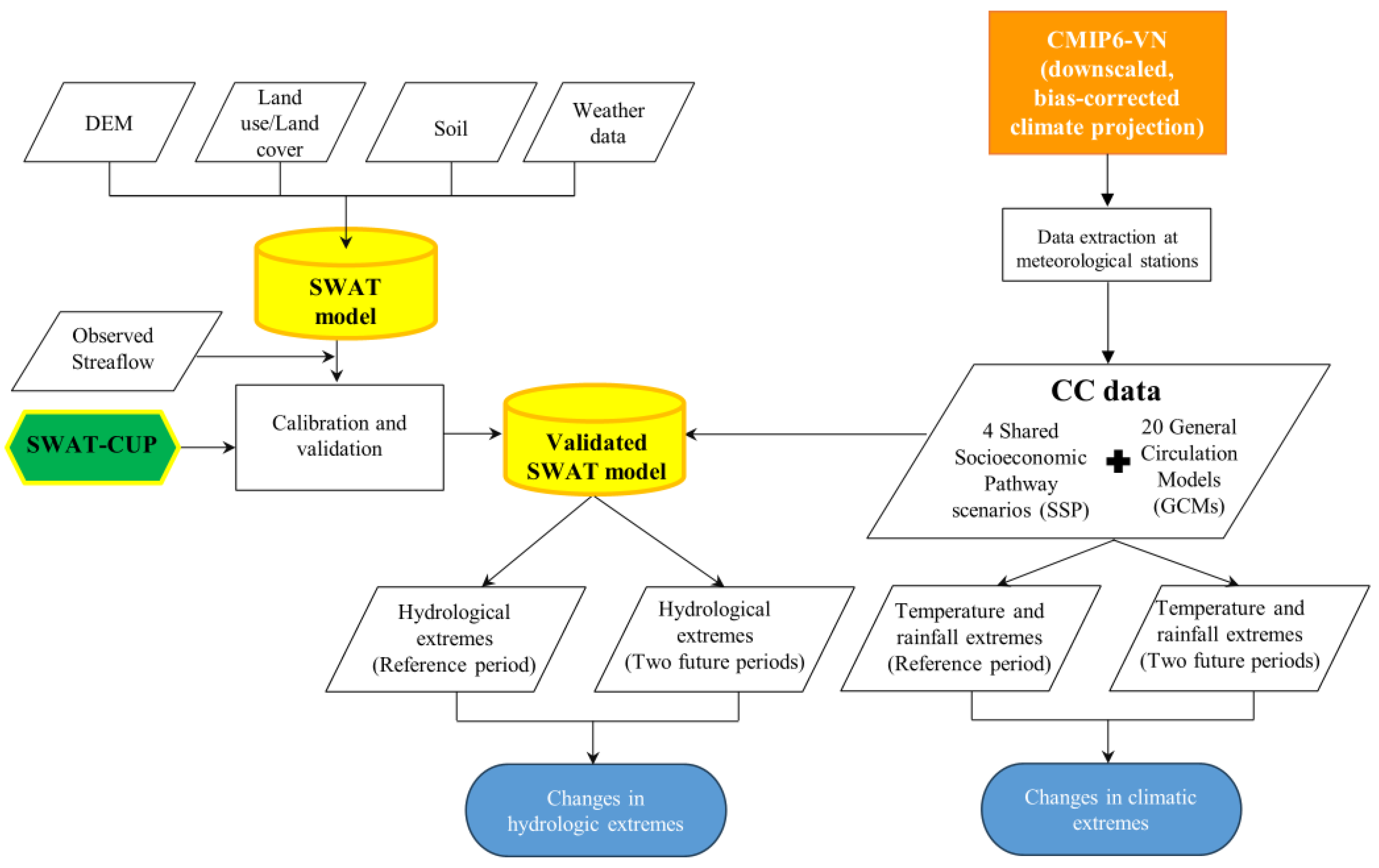

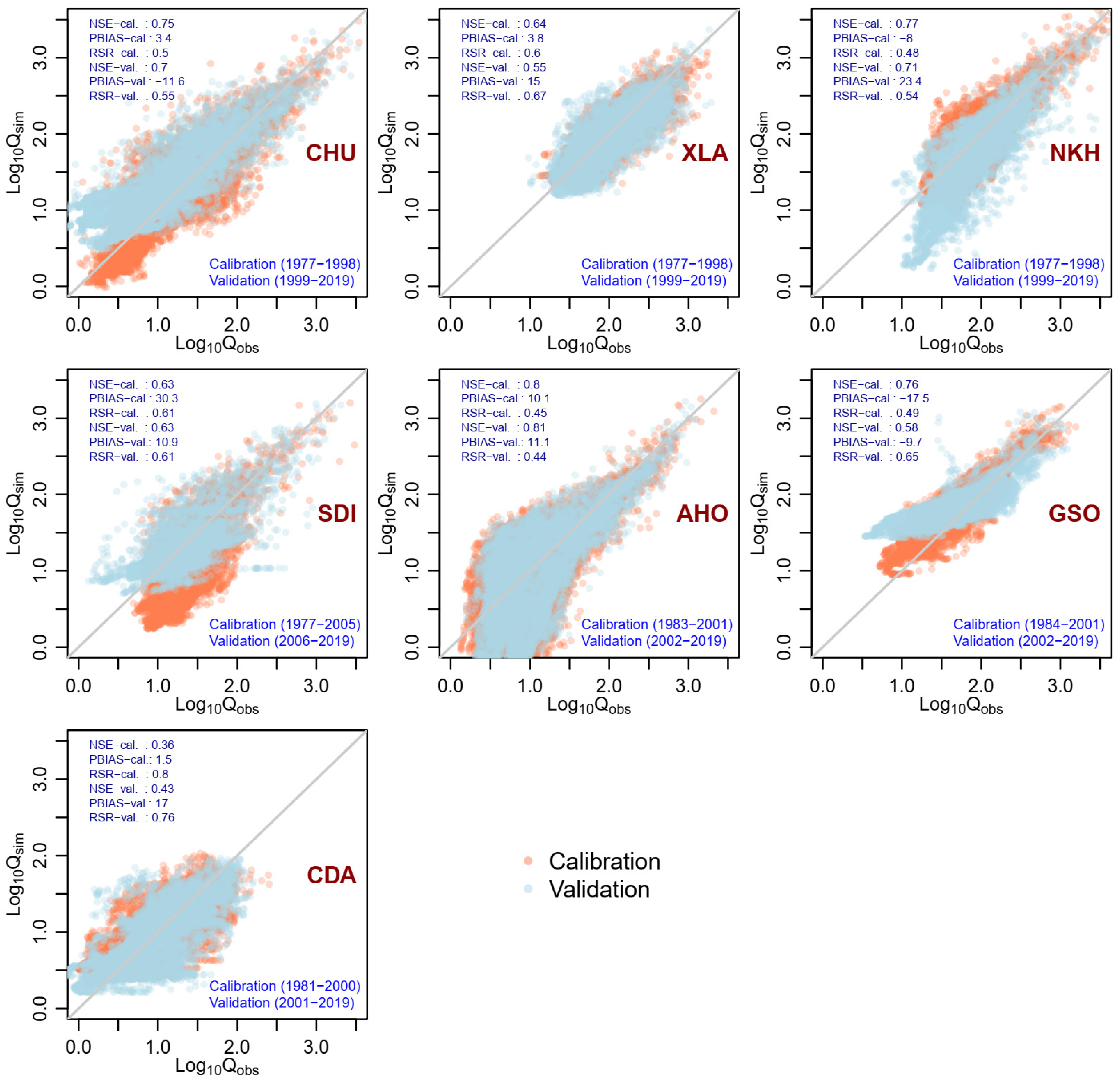
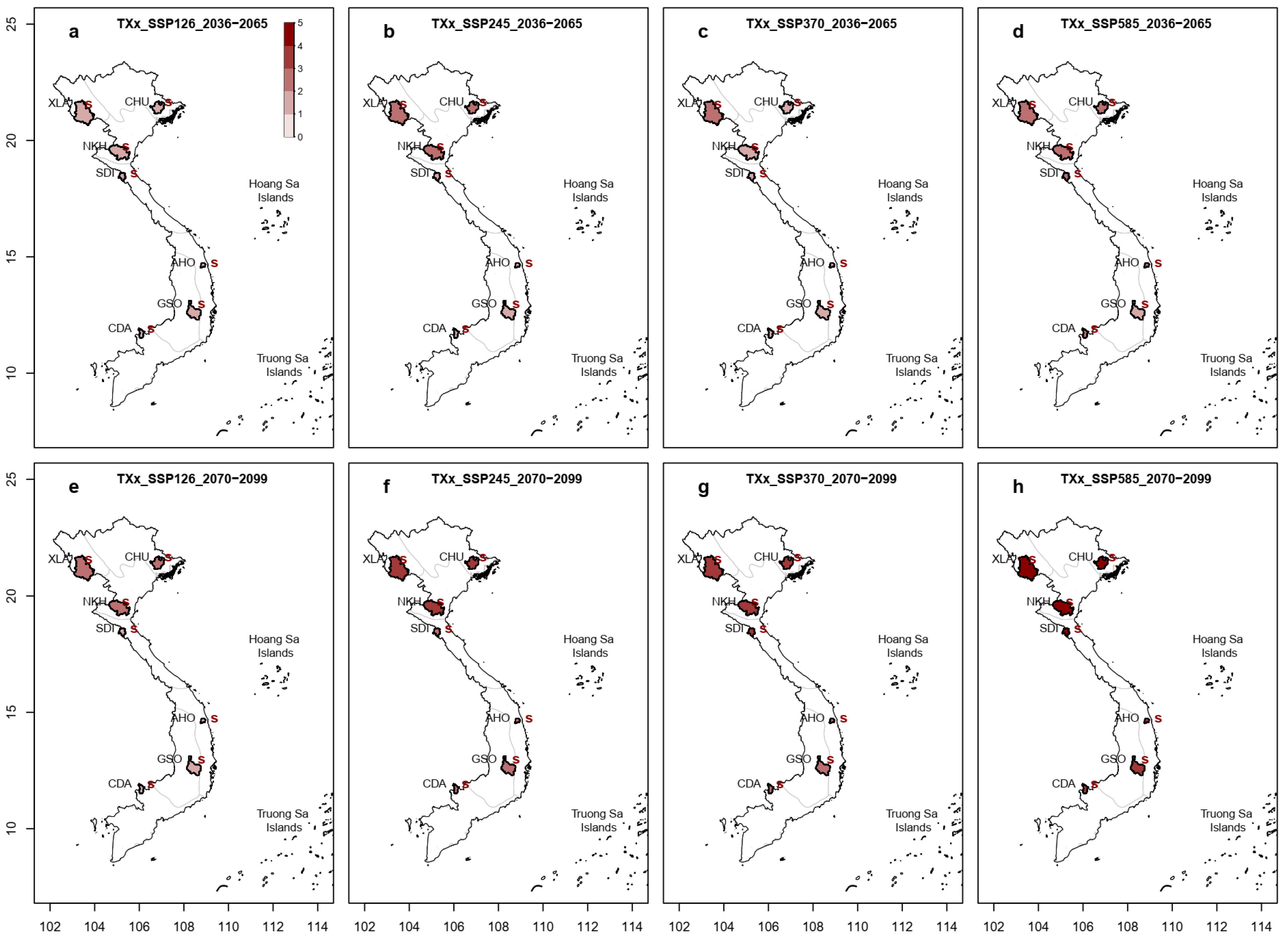
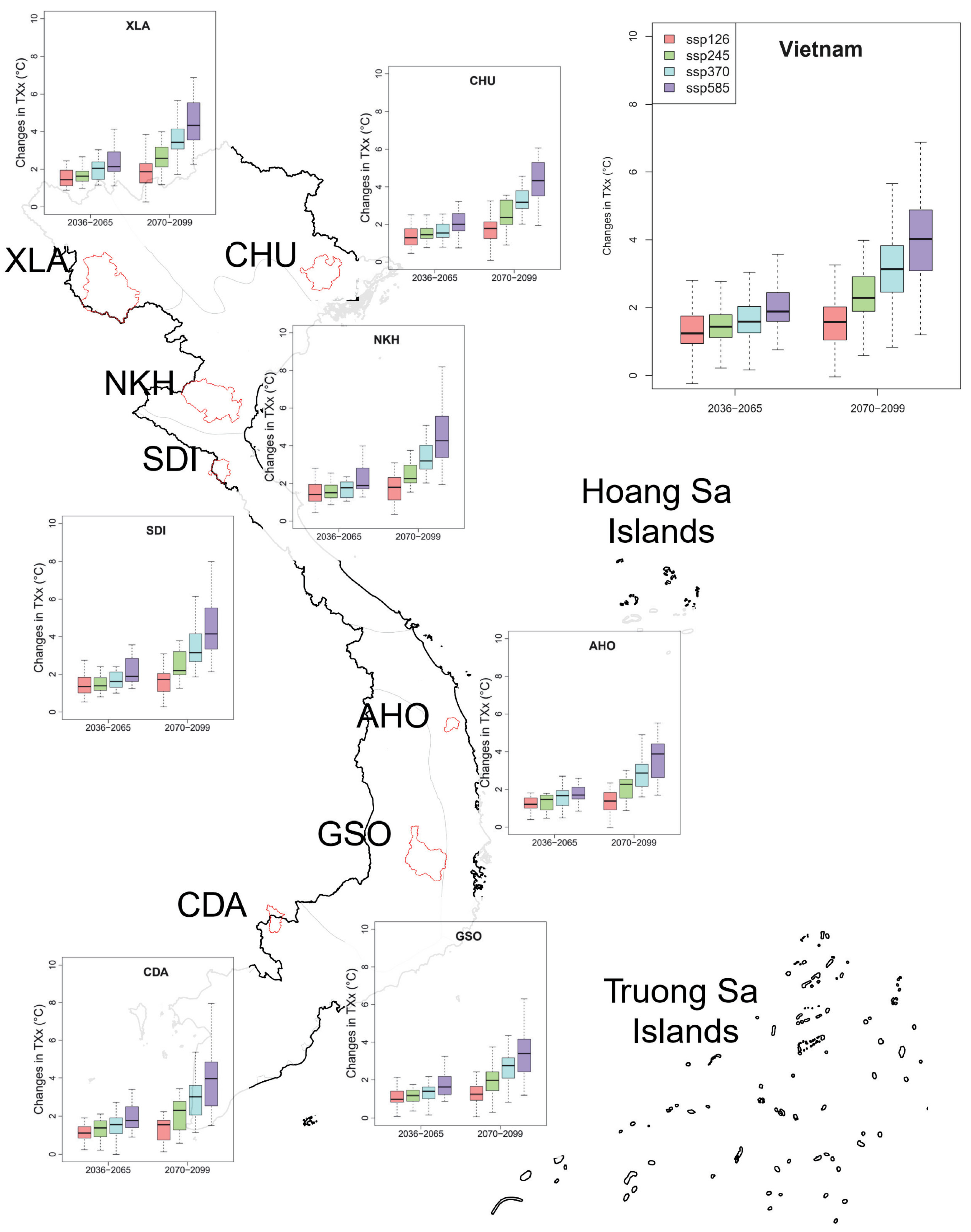
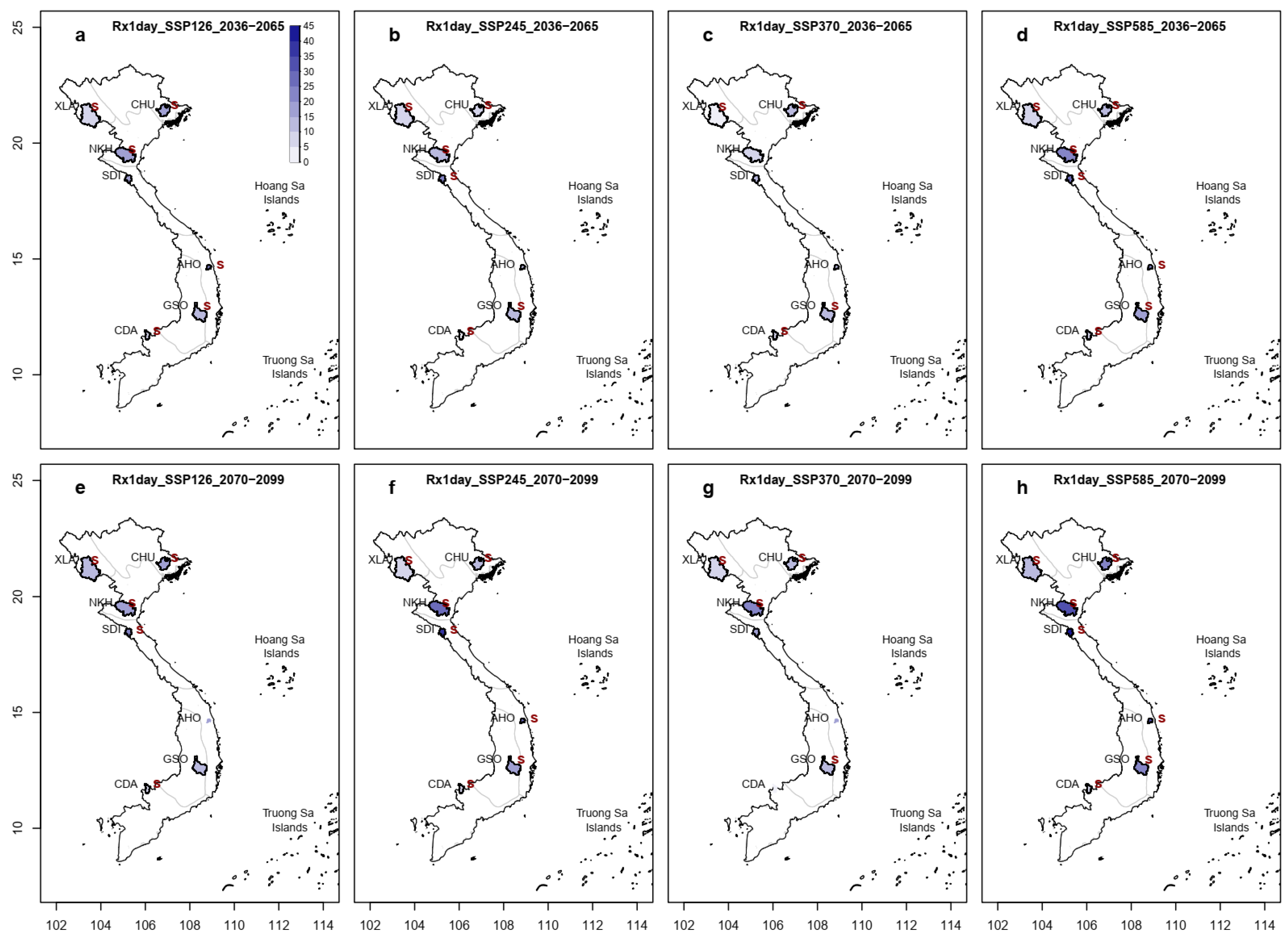

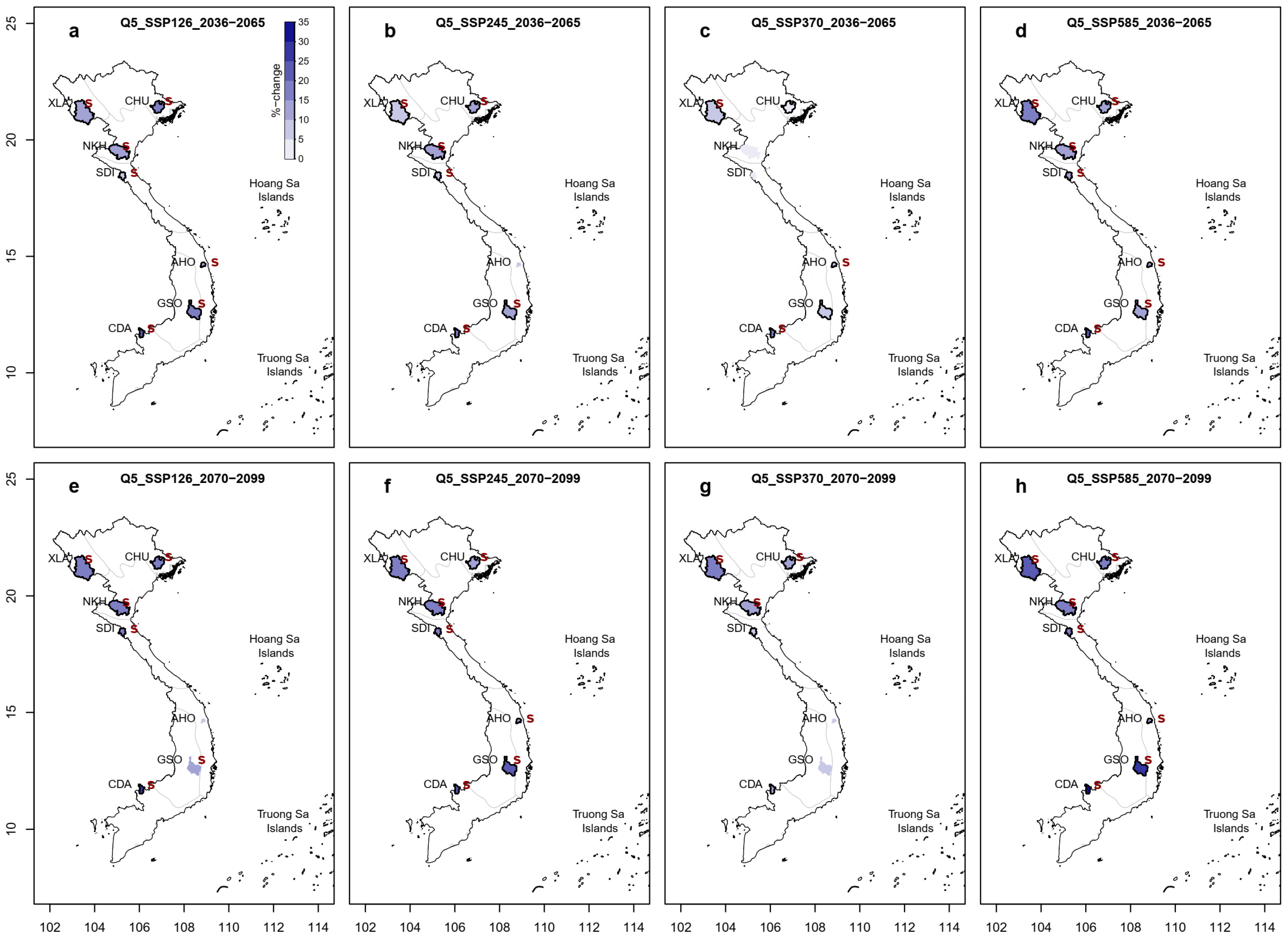
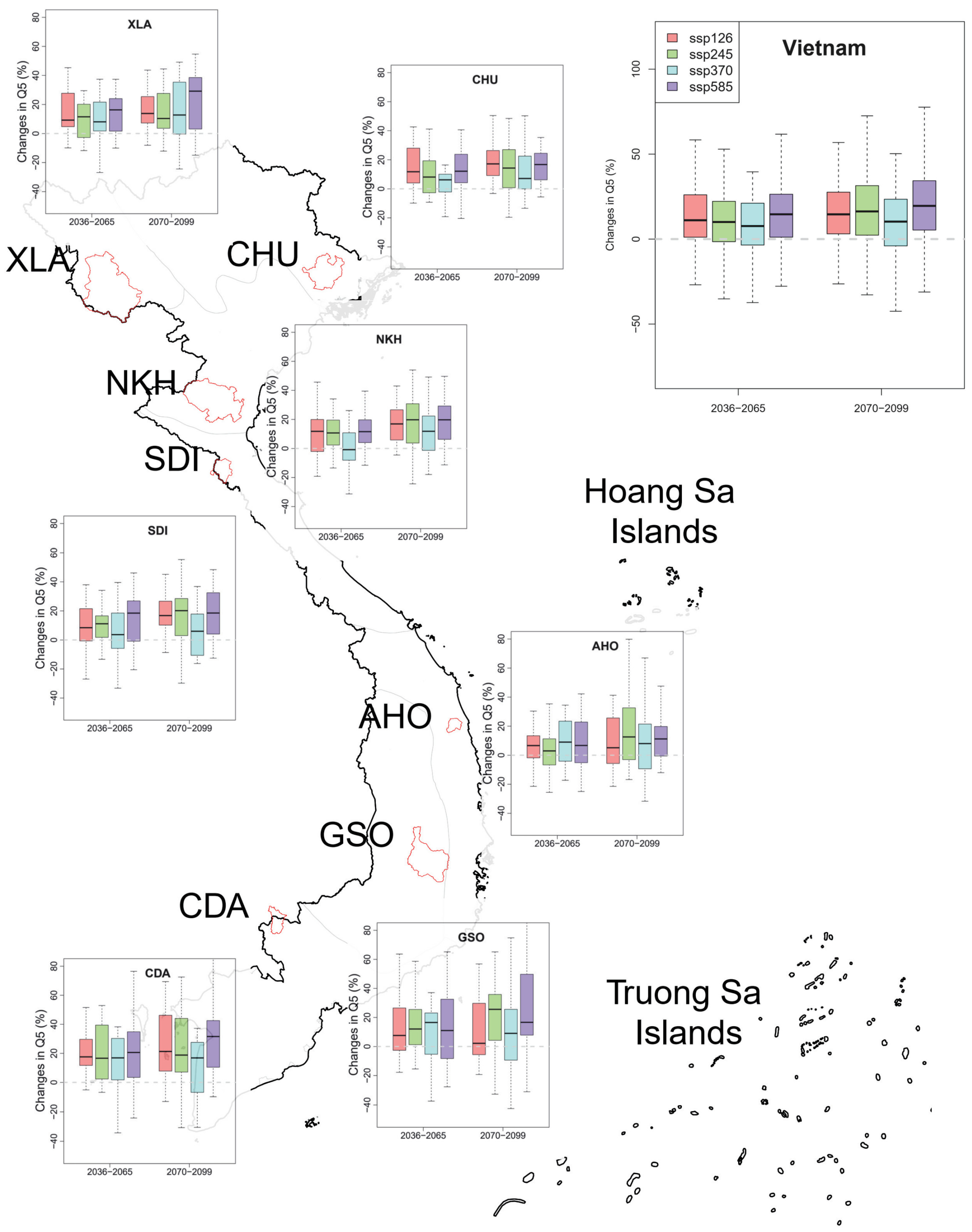
| River System | Tributary | Stream Gauge Name | Abb. Name | Number of Rain Gauges | Catchment Area (km2) | Outlet’s Longitude (Degree) | Outlet’s Latitude (Degree) | Hydro-Climate Data Coverage |
|---|---|---|---|---|---|---|---|---|
| Ma River | Ma | Xa La | XLA | 4 | 6430 | 103.485 | 21.157 | 1975–2019 |
| Red–Thai Binh River | Luc Nam | Chu | CHU | 4 | 2090 | 106.856 | 21.413 | 1958–2019 |
| Ca River | Hieu | Nghia Khanh | NKH | 3 | 4024 | 105.100 | 19.509 | 1973–2019 |
| Ca River | Ngan Pho | Son Diem | SDI | 1 | 599 | 105.242 | 18.422 | 1961–1981; 1997–2019 |
| Tra Khuc River | Tra Khuc | An Hoa | AHO | 2 | 383 | 108.848 | 14.638 | 1982–2019 |
| Mekong River | Srepok | Giang Son | GSO | 3 | 3100 | 108.436 | 12.630 | 1978–2019 |
| Sai Gon–Dong Nai River | Suoi May | Can Dang | CDA | 1 | 617 | 106.076 | 11.703 | 1980–2019 |
| Climate model | Historical | SSP1–2.6 | SSP2–4.5 | SSP3–7.0 | SSP5–8.5 |
|---|---|---|---|---|---|
| ACCESS-CM2 | x | x | x | x | x |
| ACCESS-ESM1-5 | x | x | x | x | x |
| AWI-CM-1-1-MR | x | x | x | x | x |
| BCC-CSM2-MR | x | x | x | x | x |
| CanESM5 | x | x | x | x | x |
| CIESM | x | x | x | - | x |
| CMCC-ESM2 | x | x | x | x | x |
| CNRM-CM6-1-HR | x | x | x | x | x |
| CNRM-ESM2-1 | x | x | x | x | x |
| EC-Earth3 | x | x | x | x | x |
| EC-Earth3-Veg | x | x | x | x | x |
| FGOALS-g3 | x | x | x | x | x |
| GFDL-ESM4 | x | x | x | x | x |
| GISS-E2-1-G | x | x | x | x | x |
| HadGEM3-GC31-LL | x | x | x | - | x |
| HadGEM3-GC31-MM | x | x | - | - | - |
| INM-CM5-0 | x | x | x | x | x |
| IPSL-CM6A-LR | x | x | x | x | x |
| MIROC-ES2L | x | x | x | x | x |
| MIROC6 | x | x | x | x | x |
| MPI-ESM1-2-HR | x | x | x | x | x |
| MRI-ESM2-0 | x | x | x | x | x |
| NESM3 | x | x | x | - | x |
| UKESM1-0-LL | x | x | x | x | x |
Disclaimer/Publisher’s Note: The statements, opinions and data contained in all publications are solely those of the individual author(s) and contributor(s) and not of MDPI and/or the editor(s). MDPI and/or the editor(s) disclaim responsibility for any injury to people or property resulting from any ideas, methods, instructions or products referred to in the content. |
© 2024 by the authors. Licensee MDPI, Basel, Switzerland. This article is an open access article distributed under the terms and conditions of the Creative Commons Attribution (CC BY) license (https://creativecommons.org/licenses/by/4.0/).
Share and Cite
Do, H.X.; Le, T.H.; Le, M.-H.; Nguyen, D.L.T.; Do, N.C. Future Changes in Hydro-Climatic Extremes across Vietnam: Evidence from a Semi-Distributed Hydrological Model Forced by Downscaled CMIP6 Climate Data. Water 2024, 16, 674. https://doi.org/10.3390/w16050674
Do HX, Le TH, Le M-H, Nguyen DLT, Do NC. Future Changes in Hydro-Climatic Extremes across Vietnam: Evidence from a Semi-Distributed Hydrological Model Forced by Downscaled CMIP6 Climate Data. Water. 2024; 16(5):674. https://doi.org/10.3390/w16050674
Chicago/Turabian StyleDo, Hong Xuan, Tu Hoang Le, Manh-Hung Le, Dat Le Tan Nguyen, and Nhu Cuong Do. 2024. "Future Changes in Hydro-Climatic Extremes across Vietnam: Evidence from a Semi-Distributed Hydrological Model Forced by Downscaled CMIP6 Climate Data" Water 16, no. 5: 674. https://doi.org/10.3390/w16050674
APA StyleDo, H. X., Le, T. H., Le, M.-H., Nguyen, D. L. T., & Do, N. C. (2024). Future Changes in Hydro-Climatic Extremes across Vietnam: Evidence from a Semi-Distributed Hydrological Model Forced by Downscaled CMIP6 Climate Data. Water, 16(5), 674. https://doi.org/10.3390/w16050674






